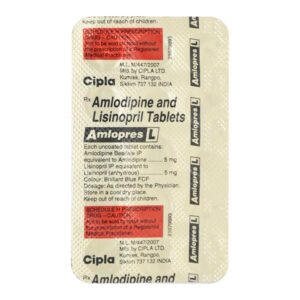LISINOPRIL + AMLODIPINE
Lisinopril: Lisinopril is a medication in the class of drugs known as angiotensin-converting enzyme (ACE) inhibitors. It is primarily used to treat hypertension (high blood pressure) and heart failure.
The mechanism of action of Lisinopril involves inhibiting the enzyme ACE, which is responsible for converting angiotensin I to angiotensin II. Angiotensin II is a hormone that causes blood vessels to constrict and promotes the release of aldosterone, leading to fluid retention and increased blood pressure. By inhibiting ACE, Lisinopril helps to relax and widen the blood vessels, reducing blood pressure and improving blood flow.
The initial dose of Lisinopril for hypertension usually ranges from 5 to 10 mg per day, which may be increased to a maximum dose of 40 mg per day depending on the individual’s response. For heart failure, the recommended dose is usually started at 2.5-5 mg once daily and increased slowly as tolerated, up to a maximum dose of 40 mg per day.
Some common side effects of Lisinopril include dizziness, headache, cough, fatigue, and gastrointestinal symptoms such as nausea, vomiting, and diarrhea. Rare but serious side effects may include angioedema (swelling of the face, lips, tongue, or throat), liver dysfunction, kidney problems, and low blood pressure. It is important to monitor blood pressure and kidney function regularly while taking Lisinopril.
Lisinopril should not be used during pregnancy, as it can harm the developing fetus. It is also contraindicated in patients with a history of angioedema, bilateral renal artery stenosis, or hypersensitivity to ACE inhibitors. It may interact with other medications, so it’s crucial to inform your healthcare provider about any other medications or supplements you are taking.
Overall, Lisinopril is an effective medication for managing hypertension and heart failure, but it should be used under the guidance of a healthcare professional and with regular monitoring.
Amlodipine: Amlodipine is a medication commonly used to treat high blood pressure (hypertension) and certain types of chest pain (angina). It belongs to a class of drugs known as calcium channel blockers.
The medication works by relaxing and widening the blood vessels, allowing the blood to flow more easily. This in turn helps to lower blood pressure and reduce the workload on the heart. In cases of angina, amlodipine helps to improve blood flow to the heart muscles, relieving chest pain.
The recommended dose of amlodipine varies depending on the condition being treated. Typically, the initial dose for hypertension is 5 mg once daily, and it can be increased to a maximum dose of 10 mg daily if necessary. For angina, the initial dose is 5 mg once daily, and it can be increased to a maximum dose of 10 mg daily if needed.
Like any medication, amlodipine is associated with potential side effects. Common side effects may include dizziness, flushing, headache, and swelling in the ankles or feet. These side effects are usually mild and transient. However, if they persist or become bothersome, it is important to inform the prescribing healthcare provider.
In rare cases, amlodipine may cause more serious side effects such as chest pain, irregular heartbeat, or severe dizziness. These should be reported immediately to a healthcare professional. It is also important to contact a doctor if any signs of an allergic reaction, such as rash, itching, or difficulty breathing, occur while taking this medication.
As with any medication, it is crucial to follow the prescribed dosage and to consult a healthcare provider before starting or stopping amlodipine. They can provide personalized advice and monitor for any potential drug interactions or contraindications based on an individual’s medical history and current medications.

